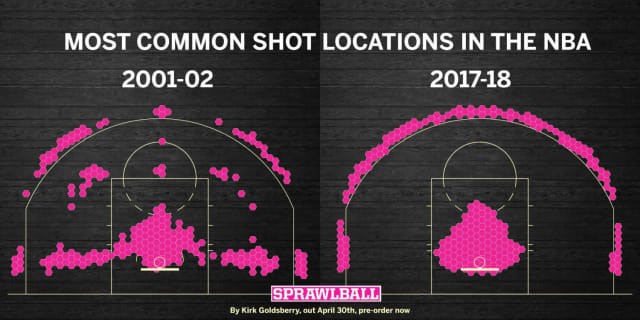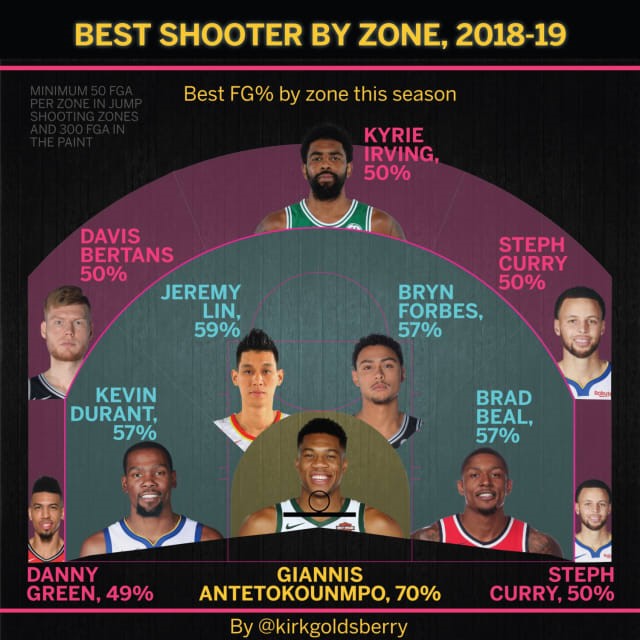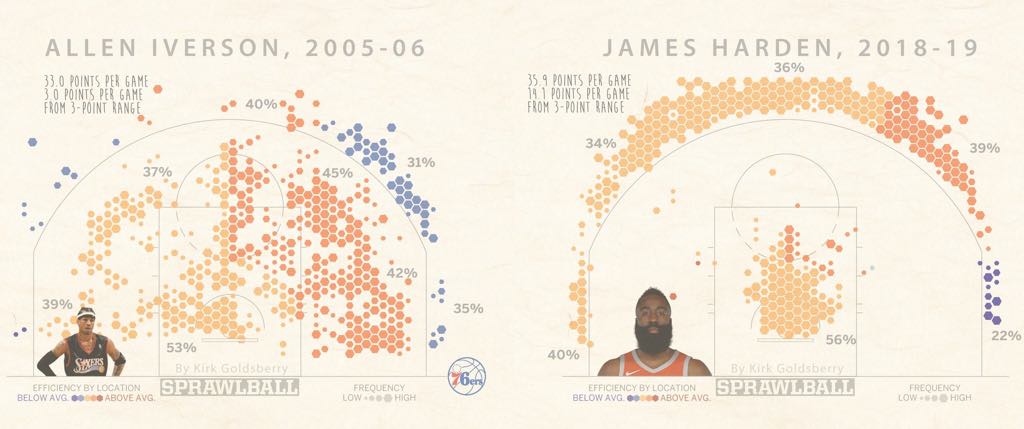The signature on its cover is that of an analytics pioneer. Kirk Goldsberry, NBA analyst at ESPN, Professor at University of Texas and former Vice President of Strategic Research for the San Antonio Spurs, has fit into “Sprawlball’s” pages quite a few tons of his experience, which can be only popularly traced back to the famous “hexagons” at Grantland. Among other endeavors, Kirk is systematically working on tracing shots, defining shot location efficiency and creating unique topographic charts, which we are sure most of you have come across to.
We are happy to host Kirk in our website and present you with a written conversation on his book, as well as on his insights on the evolution of our favorite sport (pictures from Kirk’s twitter account, at his courtesy).
Giorgos: Let’s just start with a “dumb” question – usually these generate very intriguing answers. Why should people be concerned with spatial statistics? What gap do they fill and which limitations of other advanced metrics do they overcome? What are spatial statistics anyway?
Kirk: Space matters, and spatial statistics provide a way for analysts to quantify how worldly phenomena behave in space. Together with visualization, these two approaches give us a very powerful way to study and encode information. Sprawlball is the first book to really examine basketball with these two frameworks, and I’m proud of the unique insights that emerge in the book. By the way, you can buy the book here: https://www.amazon.co.uk/Sprawlball-Visual-Tour-New-Era/dp/1328767515.
As sports become more and more analytical, the exact kinds of spatial and visual treatments at the heart of my book will become more central in sports discourse.
Panagiotis: What is the value of a good visualization in fan engagement and understanding of sports analytics?
Kirk: Man, people have loved maps for thousands of years, and it’s no secret why. Maps are the most potent documents in human history. They “show” as opposed to “tell” people things. No document can match the power of a well-designed map or visualization. Graphics are more efficient and more intuitive. I have many followers that barely speak English. They have trouble reading my articles, but clearly understand my shot charts, which is really cool, and reveals that these visual notations are often superior to written words, when it comes to communicating analytical information.
Giorgos: Kirk, you have named your book “Sprawlball”. Usually a title says a lot about the content. So, what is Sprawball and what should we expect to read within its pages?
Kirk: Sprawlball is about the rapid changes we’ve seen in pro basketball. The “sprawl” refers to the outward migration of shooting and scoring in the NBA. Sprawl itself is a geographic term used to characterize rapid – and often tasteless - suburban growth around an urban area, and it’s a concept we’ve witnessed in the NBA, as our league has become more and more obsessed with 3-point shooting. More and more of the league’s tactics are occurring further and further away from the basket. Sprawlball is about the suburbanization of the NBA scoring economy.
Panagiotis: It is a fact that three pointers and shots at the rim prevail nowadays and we can see that in your graph below. They seem like the product of natural selection in the spatial evolution of shot locations. Is there space for more change? Imagine there were a third graph for 2027-2028. What do you believe is coming next?

Great question. What I tell people is that if you like the way the NBA looks right now, then you too should advocate changes to the rules, because the dramatic changes we’re seeing are by no means complete. In fact, they are increasing in pace. We are nowhere near an equilibrium. Right now the NBA shoots just over one third of its shots from 3-point range, but some teams are closer to 50%. The 2017-18 Rockets were the first team in NBA history that took over half its shots from 3-point land. They were also the most efficient offense in the league. They won the most regular season games. There’s no reason to believe this will slow down, so left unchecked, by 2027-28 NBA teams will all look more like the Rockets than they do right now. The midrange will continue to decline in popularity, as will post play and step-back 3s will be among the most popular shots in the game.
Panagiotis: In your shooting charts, you are using four zones for the midrange shot, two for the left side and two for the right side (image below). What about the area at the top of the key, shouldn't it have a dedicated zone? We are not supporting otherwise, but we would like to fully understand the reasoning behind your zone separation.

Kirk: I have had so many different zonal configurations over the years I can’t keep track. When I worked at the Spurs, we used five zones in the midrange. The bottom line is there are no perfect ways to break up the court (although there are some terrible ways) and everybody conceives of regions in their own ways.
Panagiotis: We read that various NBA teams have taped 4-point line markings in their practice courts. Although their goal is to create more space for the offense and easier access to the rim, do you believe that there is serious possibility that the NBA adopts a real 4-point line? Or move the 3-point line further back?
Kirk: God, I hope we never see a 4-point line. It’s bad enough watching youth basketball now, with youngsters obsessed with long-distance shots, while they aren’t strong enough to shoot properly. The NBA needs to realize its impact on young players and take that seriously. The 3-point line has done enough to open up the game, and the shot has become too easy and too common for too many players. I advocate moving the line, and dedicate a whole chapter of the book to this idea. Check it out.
Giorgos: In an article in Grantland in 2015 you have written the following : "When [Gregg Popovich] says2 that team assists are the first thing he looks at after a game, as an indicator for how well his offense has performed, you should probably pay attention. Player-tracking analytics are telling us that his feeling about the relationship between assists and offensive efficiency is also correct. A quick look at the top of the assist leaderboard from last season reveals that four of the NBA’s top five teams in assists per game also rank in the top five in shooting. In today’s NBA, sharing isn’t caring — it’s winning (or it’s just the best way to get buckets).”
Watching teams like the Warriors, Spurs or the Raptors this conclusion is widely validated. However, last year, the Houston Rockets had a historically good team with ast% 55,7% , good enough for only 22nd in the league. This year they've ranked 28th. What do you think about their case? They don’t share the ball that much, yet even this year one can say that they do have a reasonable chance to compete with Golden State.
Kirk: James Harden is a transformative superstar. He’s destroying norms in our sport and it’s incredible. He gets a whole chapter in the book because what he’s doing and what he represents is so unprecedented. I want to live in a world where the best basketball teams are greater than the sum of their individual parts and isolation plays are not very efficient. For most of this decade we had that with the Spurs, Heat, and Warriors, but Harden and the Rockets have bucked that trend. It’s very innovative and we’ve already seen they can compete with GSW.

Giorgos: What was your experience in working with Coach Popovich, with regards to his attention to advanced metrics and spatial stats? Do you believe coaches are nowadays more eager to listen to analytics experts?
Kirk: The chance to work with Pop and RC Buford was incredible. Both of them are super open-minded. I can’t speak to other coaches and staffs, but yeah, analytical ideas are driving strategy in the NBA more than ever.
Giorgos: You have introduced the EPV model (Expected Possesion Value), which defines “the best possible outcome of a possession given the players on the floor and their exact position at a moment in time” (quote from “The Playmaker’s advantage”). To our understanding, and after watching the Clippers’ Courtvision, this model has been widely accepted and used by teams. Can you describe its benefits on coaching? I guess there will always be the “luck factor” somewhere in there and talent can always surprise you, but can coaches make a paradigm shift towards crafting more detailed offenses, based on such models?
Kirk: I have to give credit to Dan Cervone, Alex D’Amour, and Luke Bornn on the EPV work we did together. I’m super proud to be part of that project. The basic idea is that basketball analytics needs to be more process-based as opposed to outcome-based. We can understand what actions increase or decrease the probability of points at very precise scales. Right now, basketball analytics are very primitive, but EPV represents a new path forward.
Panagiotis: Recently, ESPN introduced Full Court Press in its first National Broadcast, using Second Spectrum Technology, offering spectators with a variety of detailed info and in-game probability data. How does this change the experience of viewing and how do you feel about lay audience acquiring/having access to similar (not identical) information with coaching staffs?
Kirk: Sprawlball is a book about the incredible changes in the NBA in the last 20 years. Everything about the league has changed, except the broadcasts. This year, the leaders at ESPN are trying some exciting new things, and I’m happy to help with that. We are trying to change the way the broadcasts look and sound. But here’s the thing: data can be distracting or overwhelming, and basketball is the star of the show. We are trying to find ways to augment the experience with emerging information without overwhelming or annoying our audiences. I think we will do it, and I think NBA broadcasts will look and feel different in the next few years because of it.





